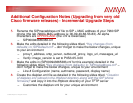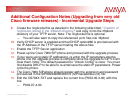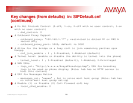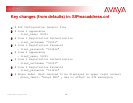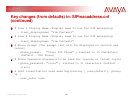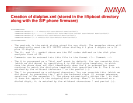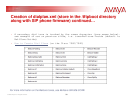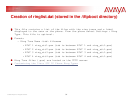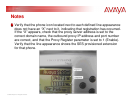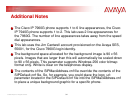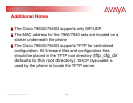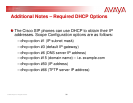
29
© 2006 Avaya Inc. All rights reserved.
Creation of dialplan.xml (stored in the /tftpboot directory
along with the SIP phone firmware)
<DIALTEMPLATE>
<TEMPLATE MATCH=“5...." Timeout="0" User="Phone" Rewrite="%s"/>
<TEMPLATE MATCH="9,1.........." Timeout="0" Tone="Bellcore-Inside" User="Phone" Rewrite="%s"/>
<TEMPLATE MATCH=“#.." Timeout="0" User="Phone" Rewrite="%s"/>
<TEMPLATE MATCH=“\*.." Timeout="0" User="Phone" Rewrite="%s"/>
</DIALTEMPLATE>
• The periods in the match string stand for any digit. The examples above will
automatically send the SIP INVITE after dialing a 5 plus 4 digits or a 91
plus 10 digits.
• The #.. and \*.. symbol above are the FAC codes defined on the dial plan
analysis form of CM.
• Comments can be entered into this file in the format <!-- Comment -->
• The # is processed as a "dial now" event by default. You can override this
(which we did above) by specifying # in the dial-plan template, in which
case the phone does not dial immediately when the # is pressed but does
continue to match the dial-plan template that specifies the #. The # is not
matched by the wildcard character * or the period (.).
• The * is processed as a wildcard character. You can override this (which we
did above) by preceding the * with the backward slash (\) escape sequence,
resulting in the sequence \*. The phone automatically strips the \ so that
it does not appear in the outgoing dial string. When * is received as a
dialed digit, it is matched by the wildcard characters * and period (.).



